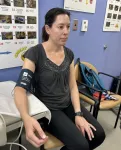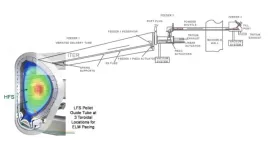(Press-News.org) A study led by Johns Hopkins Medicine researchers concludes that commonly used ways of positioning the patient’s arm during blood pressure (BP) screenings can substantially overestimate test results and may lead to a misdiagnosis of hypertension.
In a report on the study, which will be published Oct. 7 in JAMA Internal Medicine, investigators examined the effects of three different arm positions: an arm supported on a desk, arm supported on a lap, and an unsupported arm hanging at the patient’s side. Researchers found that lap support overestimated systolic pressure (the top number in a BP reading) by nearly 4 mmHg, and an unsupported arm hanging at the side overestimated systolic pressure by nearly 7 mmHg.
The findings confirm that arm position makes a “huge difference” when it comes to an accurate blood pressure measurement, says Tammy Brady, M.D., Ph.D., vice chair for clinical research in the Department of Pediatrics at the Johns Hopkins University School of Medicine, medical director of the pediatric hypertension program at Johns Hopkins Children’s Center, deputy director of the Welch Center for Prevention, Epidemiology, and Clinical Research and senior author of the study. And they underscore the importance of adhering to clinical guidelines calling for firm support on a desk or other surface when measuring blood pressure, the investigators add.
According to the American Heart Association, nearly half of U.S. adults have elevated blood pressure, a diagnosis made when the measured force of blood flowing through blood vessels is higher than what is generally considered normal, on average 120/80. Untreated, high blood pressure increases the risk of stroke, heart attack and other serious cardiovascular conditions. Because hypertension may cause minimal or no symptoms, early and frequent screening during routine checkups is considered the cornerstone of hypertension management. In most cases, lifestyle changes such as weight loss, healthy diets and exercise, as well as therapy with any of a variety of medications, can keep BP under control.
The latest clinical practice guidelines from the American Heart Association emphasize several key steps for an accurate measurement — including appropriate cuff size, back support, feet flat on the floor with legs uncrossed, and an appropriate arm position, in which the middle of an adjustable BP cuff is positioned at mid-heart level on an arm supported on a desk or table.
Despite these recommendations, the researchers say BP is too often measured with patients seated on an exam table without any, or inadequate, arm support. In some cases, a clinician holds the arm, or the patient holds an arm in their lap. In the new Johns Hopkins study, the researchers recruited 133 adult participants (78% Black, 52% female) between Aug. 9, 2022, and June 1, 2023. Study participants, who ranged from age 18 to 80, were sorted at random into one of six possible groups that differed by order of the three seated arm positions. Measurements were taken during a single visit between 9 a.m. and 6 p.m. Before BP measures were taken, all participants first emptied their bladders and then walked for two minutes to mimic a typical clinical scenario in which people walk into a clinic or office before screening takes place. They then underwent a five-minute, seated rest period with their backs and feet supported. Each person, wearing an upper arm BP cuff selected and sized based on their upper arm size, had three sets of triplicate measurements taken with a digital blood pressure device 30 seconds apart.
Upon completion of each set of three measurements, the cuff was removed, participants walked for two minutes and rested for five minutes. In the same visit, they then underwent a fourth set of triplicate measurements with their arm supported on a desk, a set used to account for well-known variations in BP readings. All of the measurements were conducted in a quiet and private space, and participants were asked not to talk to researchers or use their phones during the screening.
Researchers found that BP measurements obtained with arm positions frequently used in clinical practice — an arm on the lap or unsupported at the side — were markedly higher than those obtained when the arm was supported on a desk, the standard, recommended arm position. Supporting the arm on the lap overestimated systolic BP — the top number of a reading, or the force of blood flow when pumped out of the heart, by 3.9 mmHg and diastolic blood pressure — the bottom number, or the pressure in the arteries when the heart rests between beats, by 4.0 mmHg. An unsupported arm at the side overestimated systolic by 6.5 mmHg and diastolic by 4.4 mmHg.“If you are consistently measuring blood pressure with an unsupported arm, and that gives you an overestimated BP of 6.5 mmHg, that’s a potential difference between a systolic BP of 123 and 130, or 133 and 140 — which is considered stage 2 hypertension,” says Sherry Liu, M.H.S., an epidemiology research coordinator at the Welch Center for Prevention, Epidemiology, and Clinical Research, Department of Epidemiology, at Johns Hopkins Bloomberg School of Public Health and study author.Investigators caution that their study results may only apply during screenings with automated BP devices, and may not apply to readings done with other BP devices.
However, Brady says, the findings suggest that clinicians need to pay better attention to best practice guidelines, and that patients “must advocate for themselves in the clinical setting and when measuring their BP at home.”
Along with Brady and Liu, authors from Johns Hopkins are Di Zhao, Ahmed Sabit, Chathurangi Pathiravasan, Junichi Ishigami, Jeanne Charleston, Edgar Miller III, Kunihiro Matsushita and Lawrence Appel.
This study was supported by Resolve to Save Lives, which is funded by Bloomberg Philanthropies, the Bill and Melinda Gates Foundation and Gates Philanthropy Partners, which is funded with support from the Chan Zuckerberg Foundation.
The authors from Johns Hopkins declare no conflicts of interest.
END
Johns Hopkins Medicine study finds commonly used arm positions can substantially overestimate blood pressure readings
Investigators say failing to follow arm support guidelines during BP screening could have significant clinical impact
2024-10-07
ELSE PRESS RELEASES FROM THIS DATE:
Arm position and blood pressure readings
2024-10-07
About The Study: This crossover randomized clinical trial showed that commonly used arm positions (lap or side) resulted in substantial overestimation of blood pressure readings and may lead to misdiagnosis and overestimation of hypertension.
Corresponding Author: To contact the corresponding author, Tammy M. Brady, MD, PhD, email tbrady8@jh.edu
To access the embargoed study: Visit our For The Media website at this link https://media.jamanetwork.com/
(doi:10.1001/jamainternmed.2024.5213)
Editor’s Note: Please see the article for additional information, including other authors, author contributions and affiliations, conflict of ...
Longitudinal changes in epigenetic age acceleration across childhood and adolescence
2024-10-07
About The Study: The transition from childhood to adolescence may represent a sensitive developmental period when racism can have long-term deleterious impacts on healthy human development across the life span. Future research should build on the present study and interrogate which social regularities and policies may be perpetuating discrimination against ethnically and racially minoritized adolescents.
Corresponding Author: To contact the corresponding author, Juan Del Toro, PhD, email jdeltoro@umn.edu.
To ...
An early blood test can predict survival in patients with metastatic prostate cancer, shows USC study
2024-10-07
A blood test, performed when metastatic prostate cancer is first diagnosed, can predict which patients are likely to respond to treatment and survive the longest. It can help providers decide which patients should receive standard treatment versus who might stand to benefit from riskier, more aggressive new drug trials. The research, part of a phase 3 clinical trial funded in part by the National Cancer Institute (NCI) of the National Institutes of Health, was just published in JAMA Network Open.
Before it spreads, prostate cancer can be cured with surgery or ...
Scientists discover that special immune cells stop metastatic cancer
2024-10-07
October 7, 2024—(BRONX, NY)—Metastatic disease—when cancer spreads from the primary tumor to other parts of the body—is the cause of most cancer deaths. While researchers understand how cancer cells escape the primary site to seed new tumors, it’s not well understood why some of these wayward cancer cells spawn new tumors— sometimes decades later—while others do not.
Now, a research team at the National Cancer Institute-designated Montefiore Einstein ...
Cancer biologists discover a new mechanism for an old drug
2024-10-07
Since the 1950s, a chemotherapy drug known as 5-fluorouracil has been used to treat many types of cancer, including blood cancers and cancers of the digestive tract.
Doctors have long believed that this drug works by damaging the building blocks of DNA. However, a new study from MIT has found that in cancers of the colon and other gastrointestinal cancers, it actually kills cells by interfering with RNA synthesis.
The findings could have a significant effect on how doctors treat many cancer patients. Usually, 5-fluorouracil is given in combination with chemotherapy drugs that damage ...
Food deserts, limited access to transportation linked to more complications among preschool children with SCD
2024-10-07
(WASHINGTON – October 7, 2024) - A new study finds that preschool-aged children with sickle cell disease (SCD) who live in food deserts and have limited access to transportation are at greater risk for acute complications and hospitalizations, despite receiving free evidence-based therapy and social support, according to results published today in Blood Advances.
“Despite the level of care received by the families and patients within our clinic, we still have a gap in terms of being able to address the barriers ...
Space oddity: Most distant rotating disc galaxy found
2024-10-07
Researchers have discovered the most distant Milky-Way-like galaxy yet observed. Dubbed REBELS-25, this disc galaxy seems as orderly as present-day galaxies, but we see it as it was when the Universe was only 700 million years old. This is surprising since, according to our current understanding of galaxy formation, such early galaxies are expected to appear more chaotic. The rotation and structure of REBELS-25 were revealed using the Atacama Large Millimeter/submillimeter Array (ALMA), in which the European ...
How a common economic theory could help save endangered frogs
2024-10-07
A common theory that guides financial investment strategies may be a handy tool to protect an endangered Puerto Rican frog. A new study uses modern portfolio theory to identify future “investments” in natural resource management that may help managers decide which actions to take to protect coquí llanero populations in Puerto Rico.
The 17 species of coquí frogs, and their signature high-pitched chirp, are considered unofficial mascots of Puerto Rico. The entire population of coquí llanero frogs, the smallest and possibly most endangered of the island’s coquís, ...
Stopping off-the-wall behavior in fusion reactors
2024-10-07
Fusion researchers are increasingly turning to the element tungsten when looking for an ideal material for components that will directly face the plasma inside fusion reactors known as tokamaks and stellarators. But under the intense heat of fusion plasma, tungsten atoms from the wall can sputter off and enter the plasma. Too much tungsten in the plasma would substantially cool it, which would make sustaining fusion reactions very challenging. Now, researchers at the U.S. Department of Energy’s Princeton Plasma Physics Laboratory (PPPL) have experimental results suggesting that sprinkling ...
Real-time cancer diagnostics and therapy through theranostics
2024-10-07
Developing new cancer treatment tools, using imaging techniques such as PET-CT and MRI, and new radiopharmaceuticals for next-generation personalized therapies (“Theranostics”) to target cancer first at the “diagnosis” phase and then at the “therapy” phase, using the same biological targets (“see to treat”). Additionally, the project aims to develop and implement AI-based tools for data sharing among research and hospitals, supporting clinical decisions and predicting individual patient treatment response and outcome.
This is the main ...
LAST 30 PRESS RELEASES:
Sleeping in on weekends may help boost teens’ mental health
Study: Teens use cellphones for an hour a day at school
After more than two years of war, Palestinian children are hungry, denied education and “like the living dead”
The untold story of life with Prader-Willi syndrome - according to the siblings who live it
How the parasite that ‘gave up sex’ found more hosts – and why its victory won’t last
When is it time to jump? The boiling frog problem of AI use in physics education
Twitter data reveals partisan divide in understanding why pollen season's getting worse
AI is quick but risky for updating old software
Revolutionizing biosecurity: new multi-omics framework to transform invasive species management
From ancient herb to modern medicine: new review unveils the multi-targeted healing potential of Borago officinalis
Building a global scientific community: Biological Diversity Journal announces dual recruitment of Editorial Board and Youth Editorial Board members
Microbes that break down antibiotics help protect ecosystems under drug pollution
Smart biochar that remembers pollutants offers a new way to clean water and recycle biomass
Rice genes matter more than domestication in shaping plant microbiomes
Ticking time bomb: Some farmers report as many as 70 tick encounters over a 6-month period
Turning garden and crop waste into plastics
Scientists discover ‘platypus galaxies’ in the early universe
Seeing thyroid cancer in a new light: when AI meets label-free imaging in the operating room
Neutrophil-to-lymphocyte ratio may aid risk stratification in depressive disorder
2026 Seismological Society of America Annual Meeting
AI-powered ECG analysis offers promising path for early detection of chronic obstructive pulmonary disease, says Mount Sinai researchers
GIMM uncovers flaws in lab-grown heart cells and paves the way for improved treatments
Cracking the evolutionary code of sleep
Medications could help the aging brain cope with surgery, memory impairment
Back pain linked to worse sleep years later in men over 65, according to study
CDC urges ‘shared decision-making’ on some childhood vaccines; many unclear about what that means
New research finds that an ‘equal treatment’ approach to economic opportunity advertising can backfire
Researchers create shape-shifting, self-navigating microparticles
Science army mobilizes to map US soil microbiome
Researchers develop new tools to turn grain crops into biosensors
[Press-News.org] Johns Hopkins Medicine study finds commonly used arm positions can substantially overestimate blood pressure readingsInvestigators say failing to follow arm support guidelines during BP screening could have significant clinical impact




